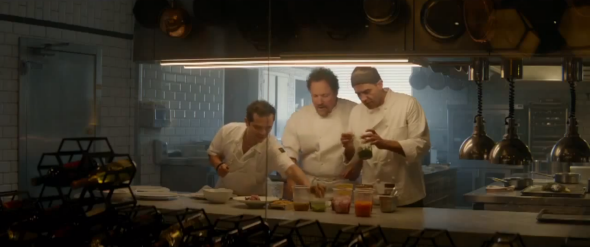Chef, John Favreau (2014)

In ‘Chef’ Jon Favreau explores parental roles and the impact of social media on job security, set to a backdrop of a culinary road trip across the US as main character Carl, played by Favreau, rediscovers his passion for cooking after a career destroying social media meltdown. The beautiful cinematography and extensive mise-en-scene of Chef is what solidified it’s status as a cult film and helped to adequately explore the vibrancy of Latin-American cooking and culture. The beginning of the film see’s Carl fall victim to cancel culture as he serves a popular but boring and overused menu to a food critic who gives a negative review which sparks Carl to respond with abuse on twitter, this exchange being familiar to contemporary audiences where cancel culture is a common occurrence that many celebrities falling victim to. By using film to deep dive into food culture, Favreau effectively brings a new medium to the phenomenon of food porn. One scene in particular stands out as displaying an erotic side of cookery as Carl prepares a dish of ‘Aglio e olio’ for love interest Molly. The simple dish shows off the sensual nature of Italian cooking and culture and the scene is now iconic for the way it does this. This scene reiterates the zeitgeist of food as a love language, as the dishes mimic the characters personalities and storylines. A scene where Carl makes a grilled cheese for his son Percy shows the beginning of Percy’s own culinary journey as the grilled cheese connotes an all American and childlike personality which is juxtaposed by a later scene where father and son bond over making Cubanos. Initially Percy asks why so much effort has gone into making the meat for the sandwiches, remarking “You could’ve just bought this at the store” but soon changes his tune begging to try the dish and helping his dad run the food truck, in turn putting him more in touch with his Latin heritage showing how food has brought people together “Cooking is all about people. Food is maybe the only universal thing that really has the power to bring everyone together. No matter what culture, everywhere around the world, people eat together.1” Carl’s identity as a white male forces audiences to read the film with a postcolonial lens, as he is effectively taking from other countries cultures and profiting from it. In an era of food tourism this cultural appropriation can often be misconstrued as appreciation as epi-curious, gastronomes endeavour to boost their cultural capital, especially considering that for many Latin immigrants in North America, a food truck is their livelihood and a way to share their culture with the public whilst for Carl this is a brief fixation that will ultimately bring him back to suburban life in middle-class Las Angeles as a top chef. The film utilises overhead shots when filming cooking scenes which help to bring more attention to the dishes being made. Lots of colour is used when creating the food, making it look more appealing but also more exotic to show Carl’s peregrination from the samey and traditional menu enforced at Gauloises where he was completely restricted in his ability to create anything contemporary, to the opening of his own restaurant with the freedom to experiment. In cooking scenes with multiple chefs’, actors were instructed to improvise a majority of their lines in order to emulate kitchen banter which effectively elevated the verisimilitude of the film. ‘Chef’ heavily relies on its score to enhance to atmosphere of the film, using iconic and nostalgic music by artists such as Gente De Zono, Pete Rodriguez and Perico Hernando’s whose Lain heritage and mariachi style deepen the roots and tone of the film.

